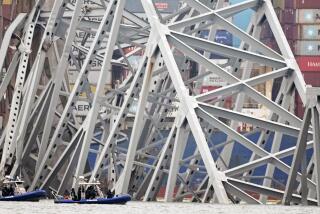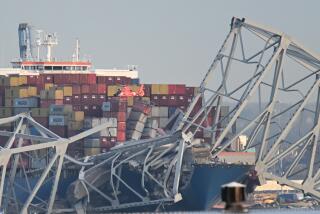Divers Confront Hazards, Horrors Amid Wreckage of TWA Jet
SMITHTOWN, N.Y. â They work on the ocean floor in frigid water 120 feet deep--a dark, murky, unforgiving place where tangles of wire and jagged pieces of shattered wreckage could entrap them and slice through their vital air hoses.
The hours are long, the work exhausting. At least two of them have suffered âthe bends,â a painful, disorienting and sometimes lethal affliction that threatens those who stay down too long or surface too quickly.
But the worst part of their job is locating and recovering the fragmented bodies of the victims of Trans World Airlines Flight 800, the Boeing 747 jumbo jet that exploded and crashed into the sea off Long Island two weeks ago, killing all 230 aboard.
âItâs one of those things where youâve got to take a deep breath once in a while,â said Navy Chief Petty Officer Kevin J. Oelhafen, one of the more than 100 divers probing the floor of the Atlantic for victims and debris. âI think itâs hard on everyone.â
Another 10 bodies were recovered Tuesday, raising the total to 171. More pieces of wreckage were brought to the surface and hauled away to an airport hangar. But there was little additional information about the cause of the crash.
Investigators are known to be focusing on the theory that Flight 800 was brought down by a bomb, but they continue to insist that the debris has yet to provide conclusive evidence about the cause of the tragedy.
Only a small fraction of the wreckage has been recovered, and Robert Francis, the National Transportation Safety Board vice chairman who heads the investigation, said that the recovery effort could stretch on for weeks, perhaps even months.
So the divers continue their arduous task, 24 hours a day, seven days a week. Some work for local law enforcement agencies, but most are Navy men based on the Grasp, a salvage ship that has been here for more than a week, and the Grapple, a sister ship that arrived here Tuesday night.
The Navy divers work in eight-hour shifts, some in âhard-hatâ diving suits fed with oxygen through hoses running to the surface, others using scuba gear with oxygen tanks strapped to their backs. Oelhafen and his partner, Petty Officer 3rd Class Douglas D. Irish, are hard hats.
They were lowered to the ocean floor shortly after 11 p.m. on July 24 after being shown pictures of what the missing âblack boxâ recording devices from the Boeing jumbo jet looked like: metal boxes, painted orange, about the size of rural mailboxes.
Irish said that the first thing he saw when he reached the bottom was an orange box.
âWe knew [what it was] right away,â he told reporters Tuesday. âIt says right on the front what it is.â
The discovery led to a burst of optimism that the boxes would provide definitive evidence about the crash. That optimism was dashed a few days later with the announcement that nothing significant had been learned.
Irish, Oelhafen and their comrades continued their work in the 46-degree water. Irish calls it one of the toughest jobs heâs encountered in more than five years of diving.
Imagine, he said, âthat you are really, really cold.â Your bulky diving suit âfeels like youâve got two or three thick jackets on, so you canât move very well.â
âYouâre walking along the bottom, trailing an umbilical cord, your air hose,â said Oelhafen. âThe visibility isnât that good. You can walk into the jagged edge of a piece of sheet metal, or step on something that is going to bounce up in your face.â
âThereâs a lot of wires down there,â said Senior Chief Petty Officer David Loring. âThings get tangled.â
Thus far, none of the divers has been seriously injured. But at least two have suffered from the bends, a condition that must be treated quickly in a decompression chamber if the victim is to escape permanent injury.
âAbout an hour and a half after they reached the surface, one had a headache,â Oelhafen said. âBoth of them were disoriented and nauseated, violently throwing up.
âShortly thereafter, we got them into the chamber,â he said. âOne immediately recovered and the other a little time after that.â
Loring said that none of the divers appears to be suffering emotionally from the grim work of recovering the mangled bodies of the victims, but he conceded that it is not an easy or pleasant task.
Neither he, Oelhafen nor Irish would talk much about that facet of their work.
âItâs out of respect for their families,â Irish said.
More to Read
Sign up for Essential California
The most important California stories and recommendations in your inbox every morning.
You may occasionally receive promotional content from the Los Angeles Times.











